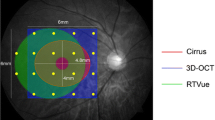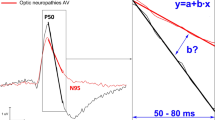Abstract
Purpose
To evaluate the correlation between multifocal pattern electroretinography (mfPERG) and Fourier-domain optical coherence tomography (FD-OCT) with regard to macular and retinal nerve fiber layer (RNFL) thickness in eyes with temporal hemianopia from chiasmal compression.
Methods
Twenty-five eyes from 25 patients with permanent temporal visual field defects from chiasmal compression and 25 healthy eyes were submitted to mfPERG using a stimulus pattern of 19 rectangles, standard automated perimetry and FD-OCT measurements. The mfPERG response was determined for groups of three rectangles for the nasal and temporal hemifields and for each quadrant. Macular thickness measurements were registered according to an overlaid OCT-generated checkerboard with 36 checks and averaged for the central area, and for each scanned quadrant and hemifield. RNFL thickness was determined for all twelve 30-degree segments around the disc, and averaged for the segments corresponding to the 6, 7, 8, 9, 10, 11 and 12 o’clock position. Correlations were verified with Pearson’s correlation coefficients and linear regression analysis.
Results
Both mfPERG amplitudes and OCT measurements were significantly smaller in eyes with temporal visual field defects than in normals. A significant and strong correlation was found between most mfPERG and macular or RNFL thickness OCT parameters.
Conclusions
mfPERG amplitudes and OCT measurements are significantly correlated in patients with chiasmal compression. Both technologies can quantify neuronal loss and, if used in combination, may help clarify structure–function relationships in this patient population.





Similar content being viewed by others
References
Holder GE (2001) Pattern electroretinography (PERG) and an integrated approach to visual pathway diagnosis. Prog Retin Eye Res 20:531–561
Hood DC, Xu L, Thienprasiddhi P, Greenstein VC, Odel JG, Grippo TM, Liebmann JM, Ritch R (2005) The pattern electroretinogram in glaucoma patients with confirmed visual field deficits. Invest Ophthalmol Vis Sci 46:2411–2418
Cunha LP, Oyamada MK, Monteiro ML (2008) Pattern electroretinograms for the detection of neural loss in patients with permanent temporal visual field defect from chiasmal compression. Doc Ophthalmol 117:223–232
Hokazono K, Oyamada MK, Monteiro ML (2011) Pattern-reversal electroretinograms for the diagnosis and management of disorders of the anterior visual pathway. Arq Bras Oftalmol 74:222–226
Luo X, Frishman LJ (2011) Retinal pathway origins of the pattern electroretinogram (PERG). Invest Ophthalmol Vis Sci 52:8571–8584
Parisi V, Manni G, Centofanti M, Gandolfi SA, Olzi D, Bucci MG (2001) Correlation between optical coherence tomography, pattern electroretinogram, and visual evoked potentials in open-angle glaucoma patients. Ophthalmology 108:905–912
Garway-Heath DF, Holder GE, Fitzke FW, Hitchings RA (2002) Relationship between electrophysiological, psychophysical, and anatomical measurements in glaucoma. Invest Ophthalmol Vis Sci 43:2213–2220
Hood DC, Anderson SC, Wall M, Kardon RH (2007) Structure versus function in glaucoma: an application of a linear model. Invest Ophthalmol Vis Sci 48:3662–3668
Bowd C, Tafreshi A, Zangwill LM, Medeiros FA, Sample PA, Weinreb RN (2011) Pattern electroretinogram association with spectral domain-OCT structural measurements in glaucoma. Eye 25:224–232
Monteiro ML, Leal BC, Moura FC, Vessani RM, Medeiros FA (2007) Comparison of retinal nerve fibre layer measurements using optical coherence tomography versions 1 and 3 in eyes with band atrophy of the optic nerve and normal controls. Eye 21:16–22
Monteiro ML, Moura FC (2008) Comparison of the GDx VCC scanning laser polarimeter and the stratus optical coherence tomograph in the detection of band atrophy of the optic nerve. Eye 22:641–648
Moura FC, Medeiros FA, Monteiro ML (2007) Evaluation of macular thickness measurements for detection of band atrophy of the optic nerve using optical coherence tomography. Ophthalmology 114:175–181
Unsold R, Hoyt WF (1980) Band atrophy of the optic nerve. The histology of temporal hemianopsia. Arch Ophthalmol 98:1637–1638
Danesh-Meyer HV, Carroll SC, Foroozan R, Savino PJ, Fan J, Jiang Y, Vander Hoorn S (2006) Relationship between retinal nerve fiber layer and visual field sensitivity as measured by optical coherence tomography in chiasmal compression. Invest Ophthalmol Vis Sci 47:4827–4835
Monteiro ML, Cunha LP, Costa-Cunha LV, Maia OO Jr, Oyamada MK (2009) Relationship between optical coherence tomography, pattern electroretinogram and automated perimetry in eyes with temporal hemianopia from chiasmal compression. Invest Ophthalmol Vis Sci 50:3535–3541
Klistorner AI, Graham SL, Martins A (2000) Multifocal pattern electroretinogram does not demonstrate localised field defects in glaucoma. Doc Ophthalmol 100:155–165
Stiefelmeyer S, Neubauer AS, Berninger T, Arden GB, Rudolph G (2004) The multifocal pattern electroretinogram in glaucoma. Vis Res 44:103–112
Langrova H, Jagle H, Zrenner E, Kurtenbach A (2007) The multifocal pattern electroretinogram (mfPERG) and cone-isolating stimuli. Vis Neurosci 24:805–816
Sliesoraityte I, Troeger E, Bernd A, Kurtenbach A, Zrenner E (2012) Correlation between spectral domain OCT retinal nerve fibre layer thickness and multifocal pattern electroretinogram in advanced retinitis pigmentosa. Adv Exp Med Biol 723:471–478
Monteiro ML, Hokazono K, Cunha LP, Oyamada MK (2012) Multifocal pattern electroretinography for the detection of neural loss in eyes with permanent temporal hemianopia or quadrantanopia from chiasmal compression. Br J Ophthalmol 96:104–109
Poloschek CM, Bach M (2009) The mfERG response topography with scaled stimuli: effect of the stretch factor. Doc Ophthalmol 119:51–58
Harrison WW, Viswanathan S, Malinovsky VE (2006) Multifocal pattern electroretinogram: cellular origins and clinical implications. Optom Vis Sci 83:473–485
Parmar DN, Sofat A, Bowman R, Bartlett JR, Holder GE (2000) Visual prognostic value of the pattern electroretinogram in chiasmal compression. Br J Ophthalmol 84:1024–1026
Monteiro ML, Costa-Cunha LV, Cunha LP, Malta RF (2010) Correlation between macular and retinal nerve fibre layer Fourier-domain OCT measurements and visual field loss in chiasmal compression. Eye 24:1382–1390
Parisi V, Manni G, Spadaro M, Colacino G, Restuccia R, Marchi S, Bucci MG, Pierelli F (1999) Correlation between morphological and functional retinal impairment in multiple sclerosis patients. Invest Ophthalmol Vis Sci 40:2520–2527
Lenassi E, Jarc-Vidmar M, Glavac D, Hawlina M (2009) Pattern electroretinography of larger stimulus field size and spectral-domain optical coherence tomography in patients with Stargardt disease. Br J Ophthalmol 93:1600–1605
Falsini B, Marangoni D, Salgarello T, Stifano G, Montrone L, Campagna F, Aliberti S, Balestrazzi E, Colotto A (2008) Structure-function relationship in ocular hypertension and glaucoma: interindividual and interocular analysis by OCT and pattern ERG. Graefes Arch Clin Exp Ophthalmol 246:1153–1162
Hoffmann MB, Flechner JJ (2008) Slow pattern-reversal stimulation facilitates the assessment of retinal function with multifocal recordings. Clin Neurophysiol 119:409–417
Chan HH, Ng YF, Chu PH (2011) Applications of the multifocal electroretinogram in the detection of glaucoma. Clin Exp Optom 94:247–258
Chu PH, Ng YF, To CH, So KF, Brown B, Chan HH (2012) Luminance-modulated adaptation in the global flash mfERG: a preliminary study of early retinal functional changes in high-risk glaucoma patients. Graefes Arch Clin Exp Ophthalmol 250:261–270
Moon CH, Hwang SC, Kim BT, Ohn YH, Park TK (2011) Visual prognostic value of optical coherence tomography and photopic negative response in chiasmal compression. Invest Ophthalmol Vis Sci 52:8527–8533
Poloschek CM, Bach M (2009) Can we do without mydriasis in multifocal ERG recordings? Doc Ophthalmol 118:121–127
Acknowledgments
Funding: Supported by grants from Fundação de Amparo a Pesquisa do Estado de São Paulo FAPESP (No 2009/50174-0), São Paulo, Brazil and from Conselho Nacional de Desenvolvimento Científico e Tecnológico, CNPq (No 306487/2011-0), Brasília, Brazil.
Financial disclosure
None.
Author information
Authors and Affiliations
Corresponding author
Additional information
ClinicalTrial.gov identifier number: NCT00553761
Rights and permissions
About this article
Cite this article
Monteiro, M.L.R., Hokazono, K., Cunha, L.P. et al. Correlation between multifocal pattern electroretinography and Fourier-domain OCT in eyes with temporal hemianopia from chiasmal compression. Graefes Arch Clin Exp Ophthalmol 251, 903–915 (2013). https://doi.org/10.1007/s00417-012-2156-8
Received:
Revised:
Accepted:
Published:
Issue Date:
DOI: https://doi.org/10.1007/s00417-012-2156-8




